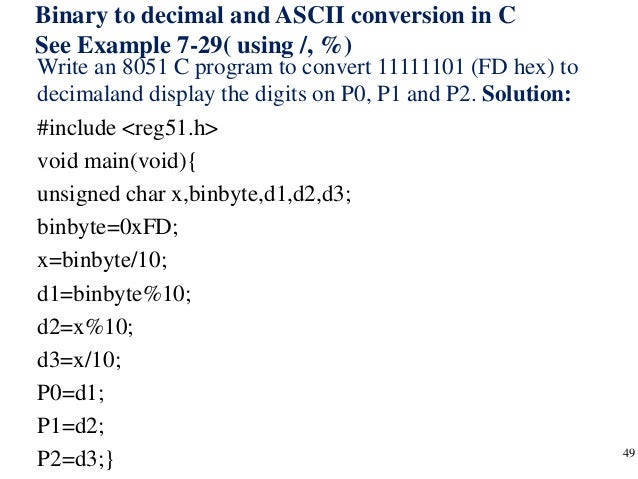Program To Convert Binary To Ascii In 8051
Code for Binary to ASCII conversion. 8051 Libraries; Miscellaneous; Binary to ASCII. Write a program to exchange the content of b register with external RAM. July (52) Program to convert ASCII to hex in 8051 Program to add two BCD numbers in 8051. In order to display binary data we need to convert it to decimal. Sample Code to convert 8 bit hex into ASCII for 8051 microcontroller.
It's not clear what you are asking since ASCII is a bit stream. In any case, especially when you have your own application on the PC, it makes sense to send data in binary over the serial line. ASCII is for humans, but you have two machines communicating with each other.
Convert Hex To Text
The PC can display the data in any form suitable for the users, but there is no need for that to be anything like the format of the data sent from the microcontroller. Since the most limited end of the communications line is the microcontroller, use the easiest format for it.

That will be just sending raw bytes. I usually use packets that start with a opcode byte, followed by whatever data is defined for that opcode.
It is simple to send and receive in a little micro, with no need for bulky and slow ASCII to binary and binary to ASCII conversion routines. On the PC side you have essentially infinite compute power relative to the speed of the serial line, so it can occomodate any format. However, raw binary is about as easy as it gets there too. About the only thing to watch for is to not make implicit assumptions about the byte order the host machine uses for multi-byte values. Define whatever is easiest for the microcontroller, then work with that on the PC end. For example, let's say the micro stores multi-byte data in least to most significant byte order.
How To Convert Binary To Octal
Don't do something stupid like define a union in C and write the received bytes into byte field overlays of wider values. That makes your host program machine-dependent. Fl studio 11 crack zippy. Instead, do the shifting and all will be OK. For example, to assemble a 16 bit quantity in a wider integer, write the first byte into it directly, then OR the second byte into it after that byte was shifted left 8 bits.
That will always work regardless of the host machine byte order. As for converting binary values to ASCII, there are various facilities for that in any language. That is a pure language problem and out of scope here, and besides is trivial anyway. @Rehan: It sounds like you are expecting to write binary data to the line at one end but have it appear as ASCII characters at the other?
It doesn't work that way. Pick a format for transmission, which I recommend to be binary. Then make sure both ends adhere to that. You apparently have some ASCII conversion going on in there one way or the other.

This can be a problem when using 'black box' libraries. Think of the serial line as transporting bytes, then work you from there yourself. – Feb 11 '13 at 13:07. What you say sounds like you're actually getting the exact bits that arrive on the port (except for start/stop bits, etc), but you have somehow fooled yourself into thinking that the contents of your variables are 'symbols'. That doesn't make sense -.NET SerialPort class will give you just raw bits, in batches of 8 bits for each C# byte or 16 bits for each C#'s char. Whether or not these bits encode symbols or something else is for you to decide.
What you choose to do with those bits after you've received them is your choice. You can choose to treat the 8 bits that sit in your byte variable as if they encode the number of an ASCII character and display that character, but nobody says you have to do that. Bits are bits; there's nothing special about those 8 bits that says that they need to be interpreted as an ASCII codepoint.
You can do whatever you want with it - byte (or, for that matter, char) is an arithmetic type, and all of the usual shifts and logical operations for manipulating bit string are at your immediate disposal. You didn't expect the SerialPort to deliver bits to you in the form of the ASCII codes for the characters '0' and '1', did you? That would be wasteful, and for most practical purposes utterly pointless.